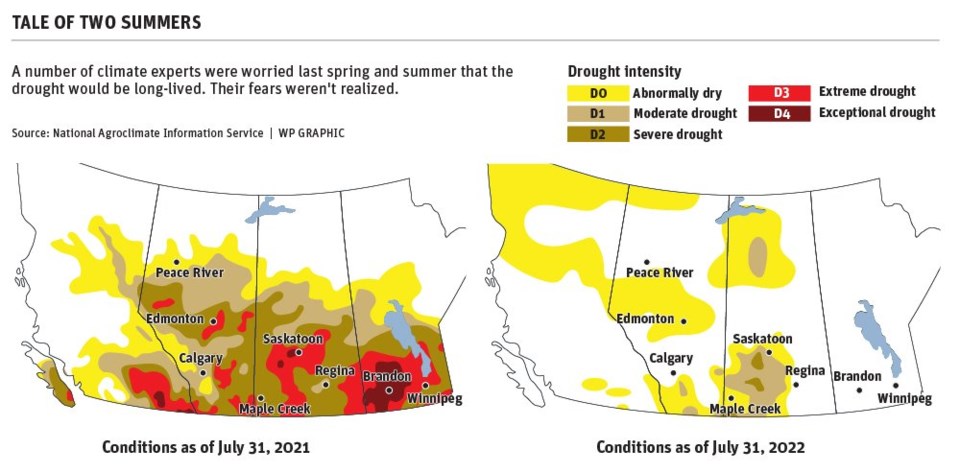WESTERN PRODUCER — The Agriculture Canada Drought Watch website has a nifty tool that uses side-by-side maps to illustrate how drought conditions have changed over time.
It’s possible to produce a drought map of Western Canada in July of 2021 and have a map of July 2022 right next to it. The difference in the two maps is stunning.
The one from last year is brown, red and dark red, indicating severe, extreme or exceptional drought. The area of drought stretches from Thunder Bay, Ont., to British Columbia.
The July 2022 map is completely different. Only a small portion is yellow or brown, indicating dryness.
“(Last summer) 94 percent of the agricultural land in Western Canada was under drought conditions,” said Trevor Hadwen, an agro-climate specialist with Agriculture Canada in Regina.
“This year, we’re (currently) under 10 percent.”
The switch from extreme drought to almost no drought represents an incredible swing in only 12 months.
“(It’s) very surprising on how the landscape has been able to recover in such a short period of time,” Hadwen said. “We had not just drought last year. We had a very intense drought. Typically, those intense droughts linger… for a fairly long time.”
Last spring and summer, a number of climate experts were worried that the drought of 2021 would persist for years. Some believed the northern U.S. Plains and Canadian Prairies were in a dry cycle or entering a lengthy period of dryness.
Based on the historical data, it is pointing that way,” said Adnan Akyuz, a North Dakota State University climatologist, last September.
The predictions of several years of drought haven’t panned out in 2022.
In early August of 2021, a map from the U.S. Drought Monitor showed all of North Dakota in some form of drought — severe, extreme or exceptional.
This summer, the map from Aug. 9 shows that no parts of North Dakota are in a drought.
A longer than normal winter and several spring storms, each dumping 50 to100 millimetres of precipitation, reversed the drought conditions in the eastern Prairies. In Alberta, rains in June and early July saved the growing season for farmers.
One of the most noticeable changes is water supplies for livestock. Last summer, hundreds of producers had to expand their dugouts or haul water for their cattle.
“(This year) we’re hearing very little concern about dugout water supplies and surface water supplies for agriculture,” Hadwen said.
“Normally, those take a longer period of time to recover.”
Conditions have drastically improved, but a few regions are still dealing with dryness.
In the area between Moose Jaw and Swift Current, the crops are relatively poor, compared to other parts of Saskatchewan.
And many pastures haven’t rebounded because of the severe drought and overgrazing in 2021.
“That’s the one holdover from last year’s drought, pastures in some areas… are still not as productive as they should be,” Hadwen said. “They were very hard hit last year.”




